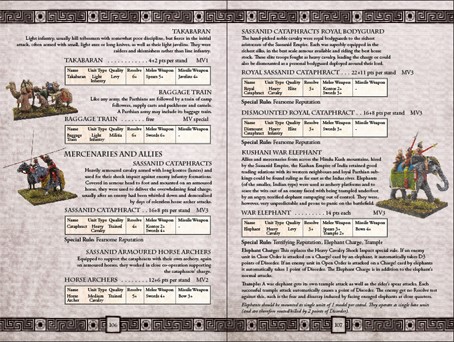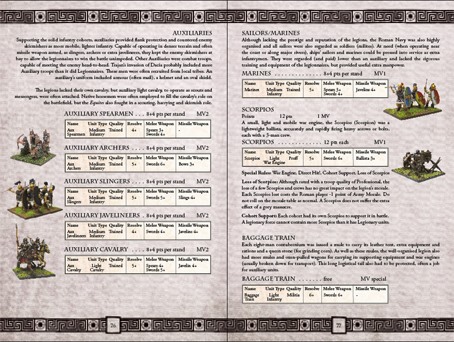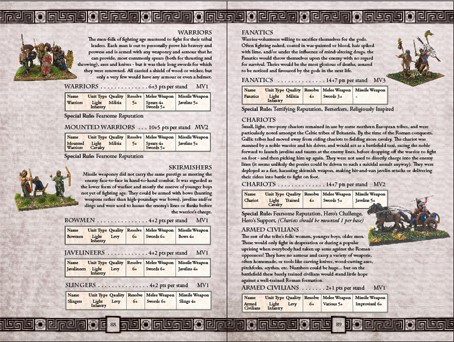Serve The Empire In New Game, Soldiers Of Rome
January 24, 2020 by avernos
Warwick Kinrade has returned to ancient history for his latest ruleset, Soldiers of Rome. Using the Soldiers of God, as a basis for the system Soldiers of Rome expands the two lists in the crusades to three in this book.
While this may not seem like a lot the focus on Soldiers of Rome, like it's predecessor, is to accurately portray the fighting style and tactics of the forces involved, something that often gets lost in generic rule sets with a broader selection of nations and lists.
The rules cover 58BC through to 180AD which as a period runs from the start of the Gallic Wars to almost the end of the Marcomannic Wars. If that's one you don't think you've heard about don't worry you have (remember the start of Gladiator? Good it was that one).
It's a fascinating period and when anyone thinks of Romans, these are generally the ones they picture. While the game itself uses d6 to resolve combat and missiles it's the card mechanic for battle plans and movement that really sets Soldiers of...apart. For this, I shall turn to Soldiers of God as I don't have a good photo of Rome yet.
As you can see above you divide your table into sections, normally 3 a left, right and centre, called Battles. Depending on your force and plan you'll receive a card for each battle that remains throughout the game. In a turn, you draw cards to your hand and then can play either those or your "battle plan" card on each of the sections.
Any units in that area can be activated, so a generic March card may be used to push all your units forward, while Advance, Loose! and Retire, would only be used by missile units. The choice is yours as commander. This is something I adore, you always have a fall back card, that is your general battle plan, what the commander came up with before the engagement and told to his sub-commanders.
Sometimes the tides of fate will bring you a card that can be so much better for you, but if not then you are not stymied and can return to your default command card. Through these and cards with random one-off effects you get a real feel for command and the armies play as you would expect them to.
The game is played in paces, with measurements and ranges being defined by them, thus allowing you to play any scale you want, and units are made of multibases so existing collections based for other games should in the main fit nicely.
There are suggested ground scales for some of the more popular sizes of miniatures, but really you could work out what best works for your group and individual set up. The lists are Early Imperial Romans, not a great surprise, Barbarians and Parthians.
While only having three lists there is scope there, with the Barbarian list being robust enough to support Britons, Gauls, Germanians, Dacians and Cantabrians, for example. Allowing you to field a force of hairy naked wild men that best suits to stave off the advance of civilisation.
The book is currently at the printers with a release planned in February from Northstar it will definitely be coming home with me
Here was a dream that was Rome. You could only whisper it. Anything more than a whisper and it would vanish, it was so fragile.
"If that's one you don't think you've heard about don't worry you have (remember the start of Gladiator? Good it was that one)"
Supported by (Turn Off)
Supported by (Turn Off)
Supported by (Turn Off)

















































































Interesting. Always fancied a go at Soldiers of God
Colour me intrigued.
Superb game engine.
The rules are the only reason I now play ancients and medievals as they feel like I imagine a battle of those periods should.
Soldiers of God is good… but Rome is even better.
Looking forward to Soldiers of Odin…
I saw him saying that. I came close to poking you to see if I could get better pictures. But then decided to stick with what Warwick had posted himself
Is there a Medival (HYW, WoR) book planned? I would snap that up – seems a dearth of period specific big battle rules for this era.
@avernos if you need any images, just give us a shout.
I have SoG and SoR here and it’s a fan game. You guys should have a go of it.
@nick2729
I’m working on Soldiers of Agincourt, which Warwick will then make into something that a human can understand… so it’s coming but we are very slow on books as it’s a part time job.
Thanks Piers – great news! I’ll look forward to that in due course. At my speed of painting I should be ready for you to publish it in, ooh say….2-years! 🙂
I have SoG I got it for my own Crusade games, it’s a corker.
I think this is the game I’ve been looking forwards to the most for years. Can’t wait to get it on the table
Nice. Was always tempted by Soldiers of God but never got around to it. Plus i have a 15mm army of Romans that i don’t really have a system for. This could be a home for them.
I buy everything Warwick Kinrade writes.
saves time in the long run 🙂
This is the way.
I ordered Soldiers of God because that darn Warren has me thinking about my next project and I haven’t even built or painted the Carthaginians for the current one yet. About to start, though…after the gnolls and beastmen and the grandson’s projects! You hobbyists don’t have any massive piles of gray laying around, do you? The book does look splendid, but Northstart takes a bit to ship to me.